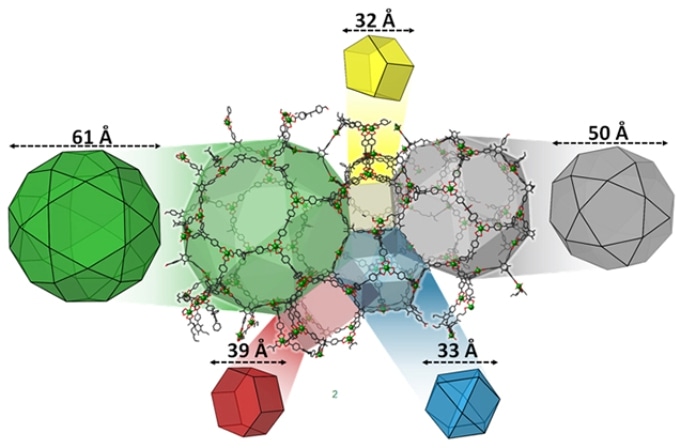Aug 21 2017
The Science
Using simple building blocks for constructing complex materials from the bottom-up is an extremely difficult task in the laboratory, but Mother Nature does this every day.
 NU-1301 is composed of cuboctahedral building blocks (blue) that organize into pentagonal and hexagonal (yellow and red) prismatic secondary structures resulting in the formation of colossal icosidodecahedral (grey) and rectified hexakaidecahedral (green) cavities with internal diameters of 5.0 nm and 6.2 nm, respectively. The cages are measured in Angstroms. (Image courtesy of N.A. Vermeulen)
NU-1301 is composed of cuboctahedral building blocks (blue) that organize into pentagonal and hexagonal (yellow and red) prismatic secondary structures resulting in the formation of colossal icosidodecahedral (grey) and rectified hexakaidecahedral (green) cavities with internal diameters of 5.0 nm and 6.2 nm, respectively. The cages are measured in Angstroms. (Image courtesy of N.A. Vermeulen)
Now, a structurally complex material has been developed by Scientists by using only two types of building blocks. Referred to as metal-organic framework (MOF), the new cage-filled or porous superstructure known as NU-1301 is relatively large having the largest unit cell of any non-biological material. This new uranium-based MOF could help energy producers and the industry.
Moreover, the NU-1301 is also the lowest density MOF reported so far. Such low density means the MOF is an extremely porous material, similar to a super sponge, which is an excellent material used for many storage applications including, but not limited to, storage of harmful nuclear waste.
The Impact
This study now shows a series of design rules. Using basic starting materials, these design rules can be currently employed for the self-assembly of highly complex, open structures. For instance, the rules can be used by Scientists to design novel materials that are capable of filtering toxic chemicals, including pollutants, in a much better way. This study also underscores the promising role of uranium and other actinides in the synthesis of complex materials.
Summary
A new three-dimensional (3D) net called Northwestern University Net (nun) is represented by the NU-1301’s structure. This net, which has been added to the reticular chemistry structure resource database, is highly intricate with 18 discrete edges and 17 topologically distinct nodal vertices.
Since the NU-1301 has a complex structure, traditional methods cannot be used to solve the single crystal x-ray structure of the ensuing MOF because the position of the uranium atoms alone can be established experimentally. Therefore, the Scientists reproduced the organic components based on the positions of the uranium atom and subsequently validated the ultimate simulated structure through other methods.
Featuring a high Brunauer-Emmett-Teller (BET) area (4750 m2/g) as well as a pore volume of 3.9 cm3/g, the NU-1301 is thermally stable to temperatures higher than 500 °C (~900 °F) under both air and nitrogen. The NU-1301’s pores are anionic in nature and also accessible, as demonstrated by the encapsulation of large biological molecules and positively charged small organic molecules that can be isolated from similar-sized negatively charged molecules.